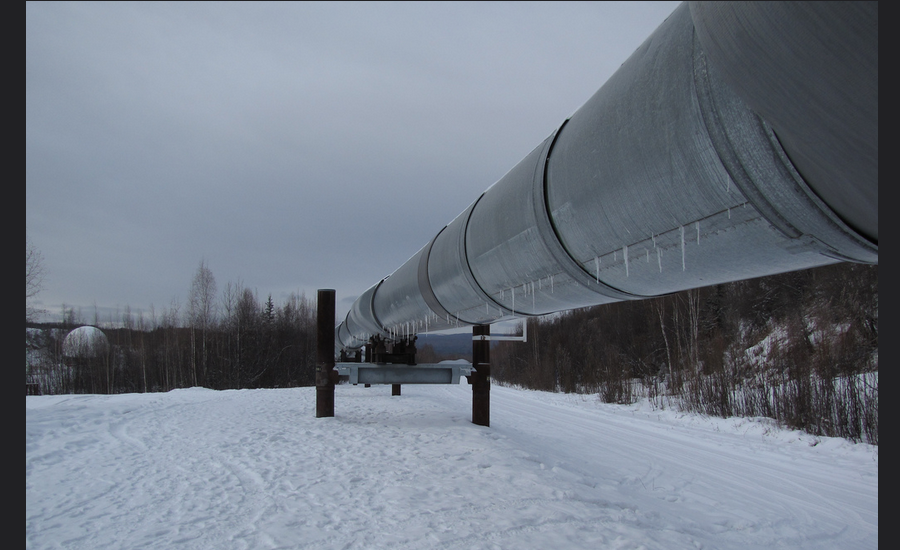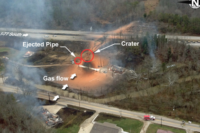Natural gas from Kentucky pipeline rupture ignited, killing one

The National Transportation Safety Board (NTSB) has released details about a deadly gas pipeline rupture that occurred in August in Lincoln County, Kentucky. The rupture in the 30-inch-diameter natural gas transmission pipeline, which was owned and operated by Enbridge Inc., a Canadian company, released about 66 million cubic feet of natural gas - which ignited. The incident caused devastation in the surrounding area; killing one person, sending six others to hospitals for treatment, destroying or damaging 19 homes and burning approximately 30 acres of land. Seventy-five residents of the Indian Camp mobile home park had to be evacuated.
As a result of the explosion, a 33.2-foot-long section of the pipeline was ejected and landed about 481 feet southwest of the rupture site.
The alarm went off at 1:24 a.m.
Initial data provided by Enbridge from its gas control center in Houston, Texas, showed that a rate-of-change gas pressure alarm was received at 1:24 a.m. for Line 15 on the south side of the Danville compressor station. The Danville compressor station operator also received the alarm. The operator told investigators he could see the fire from the compressor station. In response to the accident, Enbridge personnel isolated the affected pipeline segment while the Lincoln County Fire Protection District worked to evacuate residents and minimize the spread of the fire. The isolation of the affected segment required closing one valve at the Danville compressor station, located 3.5 miles north of the rupture, and manually closing another valve located about 19 miles south of the Danville compressor station. Enbridge personnel isolated the ruptured pipeline at 2:19 a.m. The natural gas fire was reported under control by emergency responders at 2:56 a.m.; fire suppression of the surrounding area ended at 3:20 a.m.
At the accident location, there are three Enbridge pipelines that transport natural gas from Pennsylvania to Mississippi through a common corridor. The ruptured pipe was produced by A.O. Smith Corporation and placed into service in 1957. The pipe had an electric flash-welded seam and was coated with coal tar. The rupture occurred near pipeline milepost (MP) 423.4. The portion of Line 15 at the rupture site consists of 0.375-inch wall thickness steel pipe, with a maximum allowable operating pressure of 936 pounds per square inch, gauge (psig). When first constructed, gas in Line 15 flowed south-to-north; however, in 2014 Enbridge reversed the gas flow to north-to-south.[1] At the time of the rupture, gas in Line 15 was flowing north-to-south and was operating at 925 psig. The area in which the rupture occurred had not been designated by Enbridge as a High Consequence Area (HCA).[2]
In 2011, Enbridge performed an in-line inspection of Line 15 to evaluate pipeline material properties. Enbridge performed additional in-line inspections in 2018 and 2019 to evaluate pipeline geometry. Investigators are reviewing and reassessing the in-line inspection data from the area of the rupture.
Pipelines shut down
On August 8, 2019, as a result of the accident, the Pipeline and Hazardous Materials Safety Administration (PHMSA) issued a corrective action order to Enbridge.[3] In response to the rupture, Enbridge has isolated and shut down all three pipelines in the area of the accident. Line 15 will be isolated from the adjacent pipelines from Mississippi to Pennsylvania and will operate at or below 80 percent of normal operating pressure until the terms outlined in the PHMSA corrective action order are met, and PHMSA approves Line 15 to return to full service.
Line 15 previously ruptured on November 2, 2003, in Moorhead, Kentucky, releasing about 167,100 million cubic feet of natural gas which ignited. No fatalities or injuries occurred in that accident.4 The rupture was located at MP 501.72, about 78 miles north of the Danville, Kentucky, rupture. The National Transportation Safety Board (NTSB) did not investigate the 2003 rupture.
Enbridge
An Enbridge pipeline burst in Michigan burst in July 2010, causing one of the largest inland oil spills in U.S. history. Despite the fact that alarms sounded in the company’s Edmonton, Alberta headquarters, Enbridge did not act on the spill for 18 hours - after it was reported by a Michigan utilities employee.
Michigan residents and environmental activists are currently calling for the shutdown of 60-year-old Enbridge pipelines that run through the Straits of Mackinac, citing the potential damage to the Great Lakes that could occur in the event of a rupture.
The investigation
The NTSB investigation is ongoing. While on scene, investigators collected sections of the pipeline for metallurgical analysis and testing. Future investigative activity will focus on Enbridge’s inspection and maintenance of the pipeline, HCA determination and public awareness, metallurgical evaluation of the pipe, and Enbridge’s emergency isolation procedures. Investigators will also review other inspection anomalies, reportable incidents, and the 2003 rupture.Parties to the investigation include PHMSA, Enbridge, and Lincoln County Emergency Management.
Looking for a reprint of this article?
From high-res PDFs to custom plaques, order your copy today!





